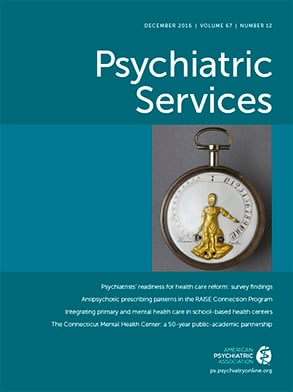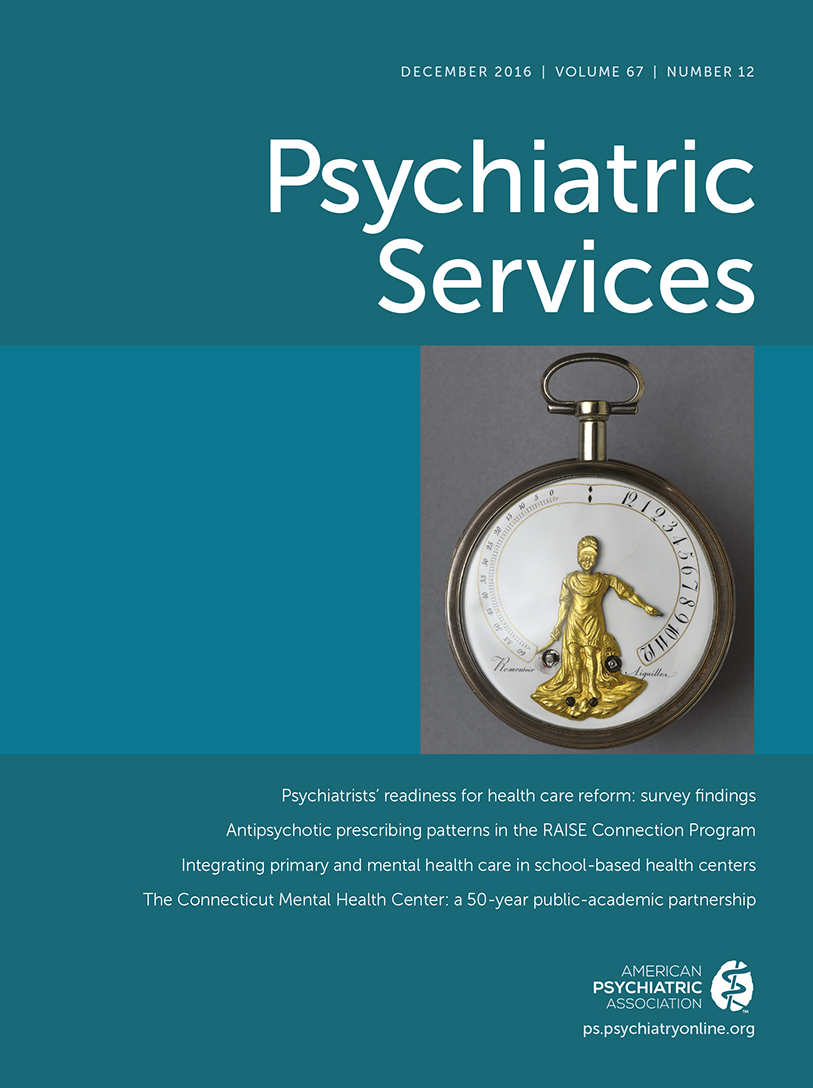Meyer’s (
1) minority stress model suggests that a dual-minority status (that is, race-ethnicity and sexual orientation) generates greater psychological vulnerability. Lee and Hahm (
2) demonstrated that Chinese-, Korean-, and Vietnamese-American lesbian and bisexual women have a greater likelihood of lifetime suicidal ideation, suicide attempts, and substance misuse compared with their exclusively heterosexual counterparts. This finding calls for more attention to their mental health and health care needs. One study showed that Asian Americans with depression have a lower rate of mental health treatment in the past 12 months compared with those from other races (
3). However, no prior studies have investigated the associations between sexual orientation and receipt of mental health treatment, receipt of adequate mental health treatment, and unmet health care needs among Chinese-, Korean-, and Vietnamese-American women.
Despite an increased awareness of the importance of service providers who are affirmative of lesbian, gay, bisexual, and transgender (LGBT) individuals, mental health professionals often exhibit “homonegative” attitudes or have little training in working with LGBT clients (
4). LGBT individuals report being denied services, being discouraged from broaching sexuality and gender issues, and feeling isolated in treatment settings (
5). Prejudicial behaviors and attitudes of mental health practitioners may predict premature termination of treatment among LGBT clients (
6). Furthermore, women from sexual-minority groups encounter more barriers to receipt of medical services compared with heterosexual women. For Chinese-, Korean-, and Vietnamese-American sexual-minority women, their multiple-minority status and the stigma exacerbated by cultural norms may further hinder them from seeking needed medical care.
For this study, we hypothesized that compared with their exclusively heterosexual counterparts, Chinese-, Korean-, and Vietnamese-American lesbian and bisexual women would be less likely to report receipt of any mental health care, less likely to report receipt of minimally adequate mental health care once care is initiated, and more likely to report unmet needs for health care.
Methods
Although the mental health status of Asian immigrants to the United States is relatively well documented, we know little about whether the children of Asian immigrants have similar health statuses or health behaviors. The Asian Women’s Health Initiative Project (AWSHIP) is the first study to investigate the mental health, sexual health, and sexual orientation of daughters of Chinese, Korean, and Vietnamese immigrants. The design of AWSHIP is detailed elsewhere (
2). We surveyed 701 Chinese-, Korean-, and Vietnamese-American women in the Greater Boston area in 2010 by using a convenience sampling strategy and recruiting participants through social media, group e-mails, and community outreach.
The recruited sample was composed of a mix of “1.5 generation” (immigrated before adolescence) and second-generation immigrants (children of immigrants) and was diverse in socioeconomic status. To be eligible, participants had to be unmarried, between the ages of 18 and 35, Chinese American, Vietnamese American, Korean American, or a combination thereof, and residing in Massachusetts. Because we were particularly interested in understanding sexual risk behaviors, we included single women only, because they are likely to have more sexual partners than married women (
7). Among 804 women who were screened, 17 were ineligible and 83 were lost to follow-up. Women who selected “not sexually attracted to men or women” (N=2) or who answered “I don’t know” (N=1) for the sexual orientation question were excluded from analyses, resulting in a sample of 701 women.
Ten community agencies and eight universities facilitated recruitment and provided space to conduct computer-assisted self-interviews (CASIs). Surveys and consent forms were offered in English, Chinese, Korean, and Vietnamese, and outreach workers and interviewers were bilingual. Twelve translators and back-translators conducted the multilingual CASI. The survey took 45 to 60 minutes to complete, and $20 compensation was provided for participants. Boston University’s Institutional Review Board approved all protocols and procedures.
We measured sexual orientation on the basis of one of seven self-identified descriptions: exclusively heterosexual, mostly heterosexual, bisexual, mostly homosexual, homosexual or gay, asexual, or “I don’t know.” Those who identified as mostly heterosexual, bisexual, mostly homosexual, or homosexual were coded as 1 (“lesbian or bisexual”) and those who identified as exclusively heterosexual were coded as 0. Those who identified as asexual or those who responded “I don’t know” were excluded from analysis. This dichotomous conceptualization of sexual orientation was used in a prior study (
2).
For dependent variables, receipt of any outpatient mental health care was assessed by the question, “How many times have you been treated for any psychological or emotional problem in outpatient counseling in the past year?” Answers were dichotomized as “none” or “any.” Consistent with evidence-based treatment guidelines (
8), minimally adequate care was measured by a positive response to either of the following questions: “Have you had at least eight outpatient mental health visits in the last year?” or “Have you had at least four outpatient mental health visits in the last year?” Asian Americans have low retention rates in mental health care (
9); therefore, we included having at least four outpatient mental health visits as an additional measure of minimally adequate care. Unmet need for medical care was determined by a positive response to the following question: “Has there been any time in the past 12 months when you thought you should get medical care, but you did not?”
The following covariates were measured: insurance status (0=no insurance, 1=public or private insurance), age (0=18–27, 1=28–35), education (low=high school diploma or less, medium=some college or college degree, high=graduate school or higher), birthplace (U.S. born or foreign born), and ethnicity (Chinese American, Korean American, Vietnamese American, and mixed among these three groups). Perceived physical health was measured by self-report; scores ranged from 1, poor, to 5, excellent. We dichotomized this variable as “poor or fair” (1) and “good, very good, or excellent” (0). Using multivariate regression models, we estimated the association between sexual identity and health care utilization, controlling for ethnicity, age, education level, birthplace, insurance status, perceived physical health, and mental health indicators.
Results
Our sample was composed of 701 women ages 18 to 35 (mean±SD=23±3) who were Chinese American (N=361, 52%), Korean American (N=153, 22%), Vietnamese American (N=137, 20%), or a mix of these ethnicities (N=50, 7%). Eighteen percent (N=129) self-identified as lesbian or bisexual. Eighty-five percent (N=595) of the sample were enrolled in college or graduated from college. In unadjusted comparisons, sexual-minority women reported a higher proportion of receiving outpatient mental health counseling compared with exclusively heterosexual women (N=28, 22%, versus N=58, 10%, p<.001). Among the 86 women who used any mental health services in the past year, lesbian and bisexual women reported a higher prevalence of minimally adequate care eight times in last year (N=10, 36%, versus N= 18, 31%), although the difference was not statistically significant.
Table 1 presents results of our multiple logistic regression models examining the association between sexual orientation and the four health care utilization measures; the analyses controlled for age, education, birthplace, ethnicity, insurance status, perceived physical health, and three mental health indicators. In contrast to our hypothesis, these models indicated that identifying as lesbian or bisexual was significantly associated with increased odds of receiving any mental health care in the past year (OR=1.95). Among those who received mental health care, lesbian and bisexual women were no more likely than their heterosexual counterparts to receive minimally adequate care in the past year. Specifically, among those who received any mental health services, only one in two women (47% [N=27] of those who were exclusively heterosexual versus 54% [N=15] of those who were lesbian or bisexual) reported receiving care at least four times in the past year. The rates of receiving care at least eight times in the past year were 31% (N=18) for exclusively heterosexual women and 36% (N=10) for lesbian and bisexual women. [Tables presenting prevalence rates of mental health utilization are included in an
online supplement to this report.] As expected, lesbian and bisexual women were significantly more likely than exclusively heterosexual women to report an unmet need for medical care (OR=2.24).
Discussion and Conclusions
Contrary to our hypothesis, our results indicate that Chinese-, Korean-, and Vietnamese-American sexual-minority women were nearly twice as likely as their heterosexual counterparts to access any mental health care in the past year, when the analysis controlled for demographic covariates, perceived physical health status, and mental health status. Although our data do not provide direct evidence that allows us to explain this finding, one plausible explanation is that sexual-minority women are more likely to reach out to mental health professionals for support because of the multiplicity of issues they face related to their sexual orientation, difficulty in negotiating HIV prevention efforts, or problems related to substance use (
10). Future research is needed to gain a more comprehensive understanding of the various factors that contribute to help-seeking behaviors among Asian-American women who are from sexual minority groups.
We found no significant differences between groups in receipt of minimally adequate care after initiation of mental health treatment, even after we controlled for mental health indicators. This finding suggests that Asian-American sexual-minority women do not encounter more barriers to mental health care than do exclusively heterosexual women. However, receipt of minimally adequate mental health care was low for both groups—31% among exclusively heterosexual women and 36% among sexual-minority women. These rates are lower than those among white (56%) or black (45%) participants with any mood disorder in the National Comorbidity Survey Replication (2001–2003) (
11).
In our study, 31% of sexual-minority women reported an unmet need for medical care; this rate is higher than that among LGBT youths overall (23%) (
12). Barriers to medical care may include provider bias, lack of provider knowledge of LGBT-specific health needs, and patients’ fear of disclosing personal information and mistrust of providers (
13). Disparities in unmet needs for health care warrant further examination of service use settings and barriers to health care among young Chinese-, Korean-, and Vietnamese-American sexual-minority women. For example, the desire for confidential services among this population may be important given that young persons from sexual-minority groups frequently seek mental health services in environments that promote higher levels of privacy and confidentiality (
14). Furthermore, health care professionals should regularly screen Asian-American women for both physical and mental health symptoms, paying particular attention to those from sexual-minority groups, who appear to be at an especially high risk of having unmet health care needs and lacking adequate care.
This study had three key limitations. First, assessing sexual orientation with self-report measures may limit the comparability of our results, because sexual orientation can be defined in several ways and from a variety of survey methods. More precise identification of lesbian and bisexual women in health research requires a multidimensional standardized assessment of sexual orientation, including sexual attraction, behavior, and identity. Second, reporting bias may lead to the misclassification of sexual orientation and mental health status; however, we do not believe this to be an issue because our study was confidential and CASI has been previously shown to be valid (
15). Third, our sample consisted exclusively of “1.5 generation” and second-generation Chinese-, Korean-, and Vietnamese-American unmarried women who tended to be highly educated. These sample characteristics may limit the generalizability of our findings to other Asian-American populations, given marked variation in socioeconomic, ethnic, and immigration statuses. Despite these limitations, our findings support the need to enhance efforts to identify and address barriers to adequate mental health care and to reduce unmet health care needs among sexual-minority women.

